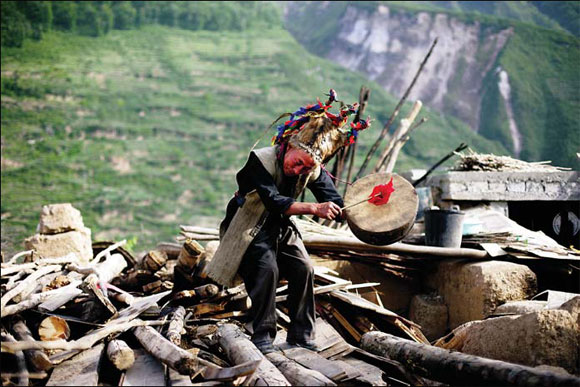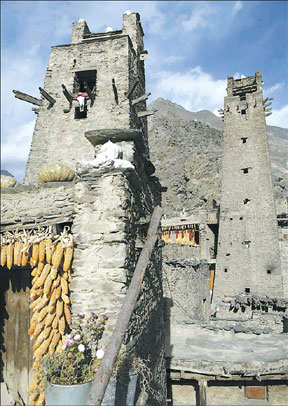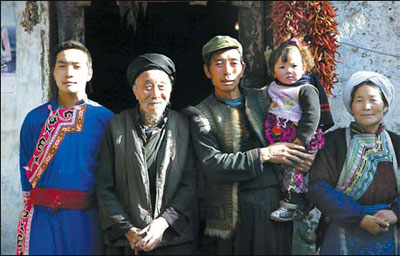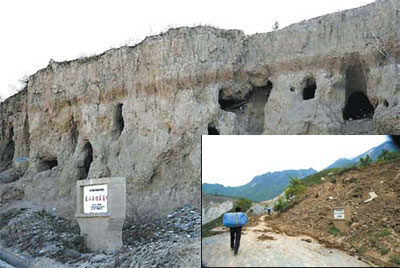Hope amid devastation
|
Wang Mingjie, a Qiang ethnic villager in Luobu village, prays on the ruins of his house. Da Shi/Southern People Weekly |
After having braved days of landslides and aftershocks, Cheng Weidong finally reached Luobu village. He paused outside its makeshift shelters, unable to think of a suitable question to ask the Qiang minority friends he had made just five months earlier.
When the 57-year-old photographer with the China Ethnic Pictorial visited western Sichuan province last November, he interviewed the most senior village elder, Zhang Fulian. The 98-year-old had smiled happily for a photograph with his great-grandchild and other members of his huge family.
|
These stone watchtowers (before the earthquake) were built more than 1,000 years ago in Taoping village, one of the most culturally esteemed Qiang villages. |
But, the May 12 earthquake leveled all the earthen houses in the village just 20 km away from the Wenchuan county epicenter. Cheng was saddened to hear the old man, along with his daughter-in-law and grandson, had been lost to the quake.
As he watched villagers dig food and clothes out of the ruins, Cheng tried to remember the house where he had chatted with the family.
"The earthquake dealt a heavy blow to the Qiang people. I really wanted to find them, but I didn't know what to say, or how I could comfort them," says Cheng, a tall, imposing man whose skin has been tanned dark brown after years on the Qinghai-Tibet Plateau.
The Qiang group is one of the country's oldest ethnic minorities whom Tibetans and other minorities of western China regard as their forebears. China's 320,000 Qiang people live in northwestern Sichuan's Maoxian, Wenchuan, Lixian and Beichuan counties, all of which were seriously affected by the quake.
Cheng and his two colleagues were the first reporters to reach the Qiang Luobu village after the quake. On his visit last year, it took him just half an hour to reach the "village on the clouds", famous for its well-preserved architecture and folk customs.
The road the local government had spent 10 million yuan ($1.43 million) building along the precipitous mountains was covered in landslides. Parts had tumbled into the Minjiang River, leaving enormous scars that gave Cheng the impression of a savagely executed oil painting.
Soldiers were preparing to carry 10 relief tents to the village. One whose home was in Aba prefecture offered to guide reporters across the pebbled slope. One wrong step on the 2-hour trek could have sent anyone tumbling into the raging river some 600 m below.
Cheng was astounded when he saw the ruins of the village. He had been struck by its simple ancient charm on his visit the previous year, when locals sunned golden corncobs on the roofs of their earthen houses. He felt numb upon hearing 44 people of the 1,100 villagers had died when their homes collapsed.
The only building that stood firm was the brick and cement primary school. None of the teachers or 200 students in the two-story building suffered injuries.
|
The photo taken last November shows Zhang Fulian (second from left), 98, with his great-grandchild and other family members. The old man, along with his daughter-in-law and grandson, died in the earthquake.Photos by Cheng Weidong unless specified |
Precious traces of early Qiang settlers in Sichuan were destroyed. Two tomb sites dating back to the Western and Eastern Han dynasties (206BC-AD220) nearby the village had also been buried in landslides.
Locals gathered under the trees to pool their belongings in temporary shelters.
Cheng spotted a stone carving. In addition to the words "Olympics" and "peace, auspiciousness", the simple carving also included a twig of red cherries, for which the area is famous. A man in his 50s said he had just done the carving.
"Although there has been a major earthquake, our country is holding the Olympics, and we must express our best wishes and support for the Olympics," the man said, gravely.
Beichuan, 168 km north of Chengdu, provincial capital of Sichuan, is the country's only Qiang autonomous county, founded in 2003. When Cheng reached the devastated area on May 18, rescuers from across the country were still searching for survivors.
Of Bechuan's 160,000 population, some 100,000 are Qiang people. But sadly, 30,000 Qiang people perished in the earthquake.
Beichuan is known as the hometown of legendary tribal leader Da Yu, who led his people to overcome rampant flooding. He later became one of three best-known kings of the Chinese nation.
The Beichuan Qiang Folk Custom Museum was totally destroyed in the earthquake. Some 800 cultural relics are still buried in the debris.
As most roads were cut off, Cheng and his colleagues rented a car and drove for some 1,000 km along an old route trodden by the Red Army in 1935 on the Long March.
The pale headlights on their car shone bright enough to reveal collapsed houses, smashed vehicles and scattered furniture. "To tell you the truth, we were afraid, as no one knew what laid ahead," Cheng recalls.
Fortunately, nothing serious happened. They set out again for Taoping, one of the most culturally esteemed Qiang villages, before dawn.
The village's most striking landmarks are its watchtowers, which stand dozens of meters tall against azure skie.
|
A tomb site of the Western and Eastern Han dynasties (206BC-AD220) before the quake. (Inset): The tomb site's remains following May 12. |
Cheng was relieved to see Taoping had suffered little damage in the disaster. The stone watchtowers built more than 1,000 years ago lost only the platform on which five white rocks are worshiped, according to Shibi ritual. Other towers, built just a few years ago to attract tourists, however, had all collapsed.
Taoping village is labyrinthine. There are 13 paths around each of the eight entrances/exits in the village. When the village was first built in 111 BC, an underground network of water passages were designed so that each family could fetch water easily.
Yang Buxian, 86, lives in the village's oldest house with her family. She invited Cheng to her home and pointed to the cracks on the wall. Other houses suffered similarly light damage, but no one in the village's 98 households were hurt.
Cheng found several village elders enjoying a pipe under the sun. "Everyone's the same. Life goes on as it always does," one of the old men said.
Local leaders have organized villagers to erect tents, and are estimating losses. Tents and food have been sent to the village, according to Long Xiaoqiong, a local tourism manager.
Cheng says the May 12 earthquake appeared more devastating than the Tangshan earthquake, which caused 240,000 casualties. He believes there was more of an impact on the people because the majority find it hard to survive without today's sophisticated forms of communication and transport.
Still, Cheng was nevertheless struck by the resilience of local villagers. He recalls that while they were at Luobu village, the cherries were ripening, and that local residents, volunteers and soldiers all joined hands in picking the fruit in an effort to compensate for losses.
"One of the villagers told us: 'As long as the trees are standing, they will bear cherries next year.'"
Cheng Weidong is a senior reporter with the China Ethnic Pictorial. Since the 1980s, the Beijing native has been to all areas where Tibetan people live. He has published hundreds of photos and won awards for his work
(China Daily 06/17/2008 page19)


















